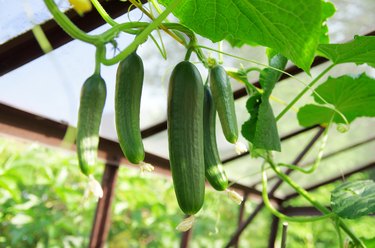
Cucumbers (Cucumis sativus) are a summer staple in the home garden, but they can fail to thrive, wilt and even die within a relatively short amount of time thanks to improper growing conditions or the presence of pests or diseases. To prevent cucumbers from wilting and dying, be sure to avoid planting them too early in the season, overwatering or planting on heavy clay-based soils. In addition, you may need to proactively spray fungicides or engage in other management techniques.
Tip
Cucumbers can wilt as a result of bacterial and fungal infections, watering excesses or deficiencies, pest infestations or poor weather conditions.
Video of the Day
Bacterial Wilt in Cucumbers
In the early stages, bacterial wilt will cause cucumber leaves to wilt during the day but look completely normal at night. Because this symptom makes it look like the plant simply hasn't received enough water or is stressed by the heat of the day, it can come as a shock when the cucumber plant suddenly takes a turn for the worse and completely dies.
Video of the Day
According to the University of Minnesota Extension, you can pin the problem on bacterial wilt by looking for the presence of striped or spotted beetles on or around your cucumber plants. These insects spread the bacteria from plant to plant. You'll also notice that the cucumber leaves eventually start turning yellow at the edges and dying but not all at once. Instead, the leaves will progressively die in a row as the disease travels further down the vine.
Squash Vine Borers Infestation
Squash vine borers plague any type of melon or squash in the garden, including cucumbers. These relatively large, cream-colored larva chew through the stem until they are inside it, and then continue to eat their way up the stem. Eventually, the plant dies, but by that time the well-fed larva is ready to turn into its adult form: a flying insect with black wings and a red back with distinct black dots down the center.
Squash Bug Pests
Another type of insect called the squash bug will gather in large numbers on the leaves and stems of the cucumber, slowly consuming the plant tissue and preventing water and nutrients from moving along the stem to the leaves or roots. As a result, the entire plant will fail to thrive until it wilts and dies.
Phytophthora Blight or Crown Rot
Phytophthora blight is caused by a fungus. According to Cornell University, an affected cucumber will have brown, damp spots on its leaves, fruit or stems, and it may also show signs of white mold growth.
In other words, the plant will look like it's in the process of rotting, and that's essentially what's happening. A fungus is eating every part of the cucumber plant, and, eventually, it will wilt, die and decompose. Cornell indicates that spraying fungicides like Ridomil Gold SL may prevent phytophthora blight in cucumbers, but it's difficult to save a plant that already shows symptoms of the infection.
Cold Temperatures or Overwatering
Cucumbers are heat-loving plants. When the soil or air temperatures get too cool for their liking, cucumbers will wilt and die. According to the University of Minnesota, cucumbers will begin to wilt and turn brown when the soil temperature is 62 degrees Fahrenheit or below or if the air temperature is 50 degrees Fahrenheit or below.
Therefore, it's crucial to avoid planting cucumbers too early in the season. Consult a resource like your local cooperative extension service or the Old Farmer's Almanac to view the historic weather trends in your zip code. Schedule your cucumber planting for when the low temperatures consistently rise above 50 degrees F. Likewise, keep an eye on your cucumbers as fall approaches and pull the wilted cucumber plants once the weather drops below 50 degrees F.
Overwatering or poor soil drainage can also cause plants like cucumbers to wilt and die. The water saturates the soil and makes it difficult for the roots to take in oxygen. Without access to oxygen and other essential gases found in the soil, the plant cannot survive. Avoid overwatering or planting cucumbers in heavy, slow-draining soils.
- University of Minnesota Extension: Cucumber: Wilting/Drooping Leaves
- University of Minnesota Extension: Bacterial Wilt of Cucumbers
- Cornell University: Phytophthora Blight of Cucurbits
- Cornell: Fungicides for Managing Phytophthora Blight in Cucurbits and Other Vegetables
- University of Kentucky: Causes of Wilting in Cucumber Vines